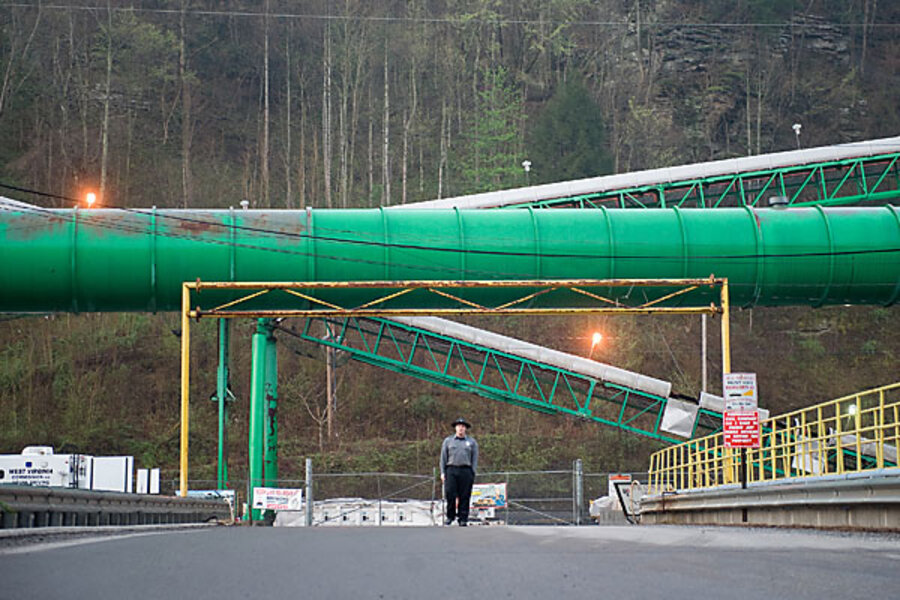West Virginia disaster: Will Congress take on coal mining companies?
Loading...
| Chicago
The deaths of 25 coal miners in West Virginia Monday in what is considered the worst mining accident in a quarter century is raising questions about whether a congressional overhaul of mine safety four years ago went far enough.
The Mine Improvement and New Emergency Response (MINER) Act, passed in 2006 in response to a disaster in Sago, W.V., that killed 13 miners, was intended to improve miner safety by mandating the installation of preventive and emergency technologies.
But Massey Energy Company, the company that owns the Upper Big Branch South Mine in Whitesville, W.V., where Monday’s accident happened, has been leveled numerous fines for environmental and safety violations in recent years.
Moreover, only 14 percent of mines have complied with MINER Act requirements to install improved communications systems.
This suggests that the MINER Act is not thorough enough in leveling consequences for mining companies or for establishing a timeline for coming to compliance, say several experts. The result is that the Mine Safety and Health Administration (MSHA) – the federal agency charged with monitoring coal companies and making them comply with safety standards – essentially has its hands tied.
“The record of [the Massey mine] is problematic, and it may be the [MINER Act] needs an additional amendment to give MSHA and the US attorneys greater power to prevent irresponsible companies from gaming the system,” says Patrick McGinley, a professor of law at West Virginia University, who enforced mine safety laws in Pennsylvania as a former special assistant attorney general.
Safety nationwide had been improving
The deaths this week actually reverse what had been a positive trend for mining deaths. Last year saw 18 coal mining deaths, compared with 47 in 2006.
The MINER Act has helped MSHA increase its inspection force, raise fines, and meet its mandate of inspecting all underground mines at least four times a year. Moreover, technologies such as extra emergency breathing devices and airtight rescue chambers designed to keep miners alive for as many as four days are slowly coming online.
But Mr. McGinley is hesitant to ascribe the improvements to the MINER Act. The newly required emergency technologies have not all been tested, and mining companies have resisted installing the new measures, often appealing their violations, McGinley says.
There has yet to be the “eureka moment” when the mines are in compliance and the technology is proven to work, says Davitt McAteer, head of MSHA during the Clinton administration and leader of the Sago disaster investigation.
More than technology, though, what is needed are stronger laws to prevent accidents, says Mr. McAteer. For instance, MINER Act doesn’t address safety practices during shift changes. Most mines require workers to walk to the bottom of shafts to relieve co-workers, rather than having the first group leave the mine before the replacement group enters – a practice that would cut in half the number of people put in harm’s way, but would temporarily halt production.
Coal companies resist changing the procedure because they want to “keep the machine running [and] coal producing, so you don’t lose 15 minutes,” he says.
MSHA's woes
MSHA is stymied as the law stands today, McGinley says. Loath to take a hard line on the industry under Bush, MSHA is trying to reassert itself, but not without difficulty.
MSHA reports that the total amount of enforcement actions taken against coal operators increased 16 percent from 2006 to 2009. But problems persist. MSHA has gotten only 34 of 491 mines to comply with a 2006 mandate that all mining companies install improved communications systems, such as two-way wireless devices that can talk with and locate trapped miners, according to a report by the Associated Press last week.
“Every disaster doesn’t have to happen,” says Christopher Shaw, a policy analyst at the Center for Study of Responsive Law, a Washington think tank. “They go back and ask, ‘Why did it happen?’ It always turns out people didn’t do what they were supposed to do.”
Industry officials say it is unfair to cast all the blame on business for the slow pace of adoption for MINER Act safety regulations. "If there is fault, the fault is that I don't think anyone got very clear guidance from the previous leadership of MSHA," National Mining Association lobbyist Bruce Watzman told AP.
But Joseph Main, head of MSHA, said that the industry was dragging its feet. He said action was being taken – MSHA took six mine operators to court in early March and cited 64 companies in Kentucky and Tennessee for not compiling with regulations – but more needed to be done to speed up the process.
MSHA “has to be serious and bring appropriate fines and actions if the operator is breaking the law,” says Mr. Shaw.
And that might require new laws, says McGinley. New legislation should give federal regulators “greater authority to bring criminal sanctions to bear … in order to hold mine managers up to the CEO level criminally responsible.”





